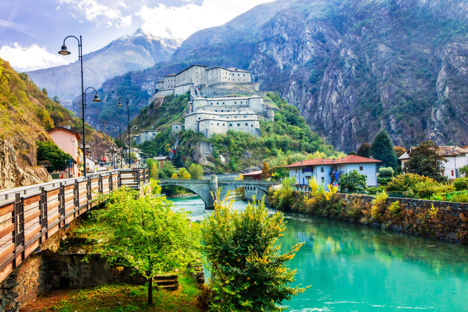
Valle d'Aosta
Italy's smallest region is a place of mountains, with Mont Blanc standing tallest among them all. But while famous ski resorts such as Courmayeur attract throngs of tourists, the valleys and pastures amongst the peaks are where you'll find the most interesting food and drink. Discover more about this tiny corner of northwest Italy and cook some its most famous recipes.
Valle d'Aosta
Italy's smallest region is a place of mountains, with Mont Blanc standing tallest among them all. But while famous ski resorts such as Courmayeur attract throngs of tourists, the valleys and pastures amongst the peaks are where you'll find the most interesting food and drink. Discover more about this tiny corner of northwest Italy and cook some its most famous recipes.
With just one province (Aosta), Valle d’Aosta (sometimes known as the Aosta Valley or Val d’Aosta) is the smallest region in all of Italy. Sitting right at the northwest tip with Piedmont to the south and east, France to the west and Switzerland to the north, it’s almost entirely covered in mountains. The Alps’ tallest peaks all fall within its boundaries, and its ski resorts are some of the best in Europe. But away from the après-ski hot chocolates and nibbles, there’s some incredible cooking to be found. Rather than the pasta, tomatoes and fresh herbs found further south, Aostan dishes are all about rich, hearty fare – after all, you need a good feed to stave off the colder weather.
The region’s most famous product is Fontina cheese, made since the twelfth century and PDO-protected. It’s melted into soups, is an integral part of the local fondue (known as fonduta) and is, of course, present on any cheeseboard in the area. Beef and goat stews are popular, and polenta is the main staple (as opposed to rice or pasta), usually enriched with plenty of butter and yet more Fontina. Earthy rye breads and cured meats are often served at the beginning of a meal, while nuts and orchard fruits are used in a variety of desserts. Winemaking is also an important part of Valle d’Aosta’s culinary heritage, with red and white wines produced in both the deep valleys and the high mountains.
For such a small region, Valle d’Aosta certainly has a lot to offer the intrepid foodie. Read on to get a better understanding of the area’s food and drink, then try some of the traditional recipes that Aostans hold dear.
Rich and hearty
Living in the alpine mountains means rich, hearty and robust cooking is needed – and in Valle d'Aosta, that makes beef the most popular meat. From filling stews to humble soups, these are two of the dishes that best encapsulate the local style of cookery.


